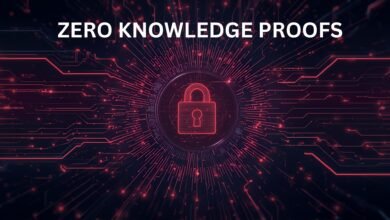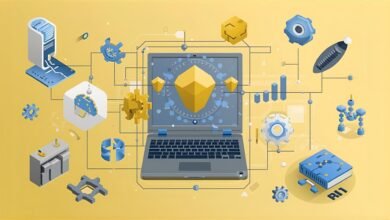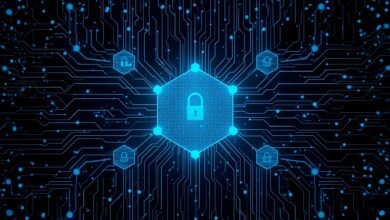
Personal data has become the fuel that drives these systems. Every click, like, message, location ping, biometric scan, and purchase contributes to a sprawling digital dossier about who we are. The problem is that most of that data is collected, stored, and monetized by centralized platforms, with minimal transparency or control for individuals. In effect, AI is gobbling our personal data—and we rarely know how it’s being used, sold, or repurposed.
Yet, a powerful counterbalance is emerging. Meets Blockchain Shield: Recent advances in blockchain and related cryptographic tools offer a path toward reclaiming control, enforcing privacy, and restraining the data appetites of AI systems. In this article, we’ll explore how AI currently devours personal data, the privacy risks therein, and how new blockchain-driven techniques can stem that tide. We will dive into decentralized identity, zero-knowledge proofs, secure multi-party computation, federated learning, and hybrid architectures that combine AI and blockchain in privacy-preserving ways. Along the way, we’ll examine real-world challenges, regulatory constraints, and the roadmap ahead.
This is not just a technical narrative: it is a privacy awakening. As AI continues to scale, we must build systems where users control their data, not the other way around.
The AI Data Economy: Why our information is at risk
How AI systems “eat” personal data
Modern AI models learn from vast troves of data. To make recommendations, detect fraud, drive autonomous systems, or generate content, these models require training on rich, labeled datasets. That means personal data—ranging from browsing histories to health records—is aggregated, anonymized (or not), and fed into centralized servers. Over time, these systems build profiles, infer traits, and make predictions with profound influence over decisions in credit scoring, insurance, ad targeting, employment, and even civic engagement.
Notably, AI systems are often black boxes. Users seldom know which features contributed to a decision or how their raw data was processed. The concentration of data amplifies the risk: a single breach or misuse can expose deeply personal information of thousands or millions. Because so much of this happens behind closed doors, we have little visibility into how our data is being used, sold, or licensed.
Privacy risks and harms
When personal data is centralized and opaque, multiple risks arise:
- Re-identification: Even if data is anonymized or aggregated, clever adversaries can re-link patterns to real individuals.
- Profiling and discrimination: AI models may embed bias, leading to unfair treatment in credit, hiring, insurance, or policing.
- Consent abuse: Data collected for one purpose (say, “improving service”) may be repurposed for AI-training in unrelated domains, without genuine user consent.
- Breach risk: Centralized data stores present juicy targets for hackers, leaks, or insider misuse.
- Opaque monetization: Users rarely see revenue from the data they produce, while corporations profit from AI-powered insights.
In short: the current data model empowers platforms—not people.
How blockchain can invert the dynamic: Meets Blockchain Shield
Decentralization, transparency, and user sovereignty
At its core, blockchain is a decentralized, immutable ledger system. Transactions or state updates are replicated across many nodes, removing a single point of control. This decentralization can help counter the monopolistic control that tech giants now exert over personal data.
By storing hashes, pointers, or control logic on-chain while leaving sensitive data off-chain, blockchain can maintain audit trails and enforce consent rules without exposing secret data. In effect, blockchain becomes a control plane rather than a data plane.
The blockchain can record user consent, access rights, revocation events, and audit logs in a transparent, tamper-evident way. This means users can see who accessed their data, how often, and under what terms. That transparency builds trust and accountability.
However, blockchain’s transparency is a double-edged sword. Putting raw personal data on-chain is typically a privacy violation, especially under regulations like the GDPR’s “right to erasure.” Accordingly, hybrid models (with off-chain storage encrypted and on-chain pointers) are often preferred.
Zero-knowledge proofs & privacy-preserving cryptography
To reconcile blockchain’s openness with privacy, we need advanced cryptography. One of the most promising tools is zero-knowledge proofs (ZKPs), which allow one party to prove a statement is true without revealing the underlying data. For example, I can prove I’m over 18 without exposing my actual birthdate.
By combining ZKPs with blockchain, systems can verify assertions about private data (e.g. creditworthiness, membership, identity) without revealing the raw data. This keeps personal information private while enabling trust and verification in a decentralized environment.
Other cryptographic techniques like secure multi-party computation (SMPC) and homomorphic encryption also allow computations on encrypted data, making it possible for AI operations to occur without exposing raw inputs. For example, an AI model could train on data held across many nodes without ever centralizing the raw data.
Federated learning anchored by blockchain
Federated learning is a distributed AI training paradigm: instead of collecting raw data at a central server, models are trained locally on users’ devices, and only model updates (gradients) are sent to a central aggregator. That way, raw personal data remains local.
Blockchain can act as a coordination and trust layer in federated learning: tracking which participants contributed updates, verifying integrity, managing incentives, and reconciling updates in a tamper-resistant way. Some architectures merge federated learning, blockchain, and cryptographic guarantees to deliver privacy-preserving AI over decentralized networks.
Decentralized identity and self-sovereign identity (SSI)
A central pillar of reclaiming data control is decentralized identity (DID) or self-sovereign identity (SSI). Here, individuals hold cryptographic keys and control identity attributes themselves, rather than relying on centralized identity providers like Facebook or Google.
Blockchain plays a role by storing decentralized identifiers or revocation registries, while the sensitive identity attributes remain in the user’s control (e.g., in a secure wallet). When a service asks for identity proof, users can selectively disclose attributes (using ZKPs or verifiable credentials) rather than giving full identity dumps.
Because identity is tightly bound to personal data control, SSI helps enable systems where users dictate who can access what—and under what conditions.
Emerging frameworks & research breakthroughs
opp/ai: privacy-preserving AI on blockchain
A recently proposed framework called opp/ai (Optimistic Privacy-Preserving AI) aims to balance privacy and performance in AI deployed on blockchain networks. It integrates zero-knowledge machine learning (zkML) with optimistic execution to reduce overhead while maintaining cryptographic guarantees.
Opp/ai is an example of how the convergence of AI and blockchain is pushing beyond theory into efficient, pragmatic systems.
Enigma & secure decentralized computation
Earlier work like Enigma pioneered private, decentralized computation where multiple parties can jointly compute on secret-shared data without revealing inputs. The blockchain functions as an access control log and orchestrator, while the computation happens off-chain in a privacy-protecting manner.
This model is directly relevant to protecting personal data while still enabling collaborative AI tasks like recommendation systems or federated analytics.
DeAI (Decentralized AI)
Recent systematization efforts for Decentralized AI (DeAI) explore how combining blockchain with AI can deliver fairness, transparency, and privacy. These architectures envision AI ecosystems where models, data, and incentives are decentralized—not controlled by a single company.
DeAI seeks to dismantle the conventional paradigm where a few tech giants aggregate data and control models. Instead, we may get ecosystems where users own their data and AI models learn in permissionless, transparent, and privacy-first environments.
Real-world applications & pilot systems
Privacy-conscious healthcare and genomics
Healthcare data is among the most sensitive, and AI models for diagnosis or personalized medicine demand large datasets. Some pilot implementations combine blockchain access logs, homomorphic encryption, and federated learning to allow hospitals or patients to contribute data without exposing raw health records. In these deployments, blockchain ensures auditability and consent tracking, while computation is performed securely across nodes.
AI-mediated IoT systems
IoT (Internet of Things) devices generate continuous streams of personal data—e.g. smart home sensors, wearables, cameras. Integrating blockchain with edge AI and encrypted data processing allows devices to collaborate intelligently without centralizing all data. Some studies propose blockchain nodes running AI-driven intrusion detection or privacy-preserving analytics on encrypted IoT data.
Media companies are exploring blockchain-backed licensing and AI usage control: for instance, Fox Corp launched a Verify protocol on blockchain to trace how content is used by AI models, embedding cryptographic provenance and usage constraints.
This approach allows creators to negotiate AI access, limit scraping or reuse, and enforce royalties and transparency.
Decentralized search & privacy-first web tools
Projects like Presearch, a decentralized, privacy-oriented search engine built on blockchain, aim to reduce centralized logging of search queries. Presearch architecture claims not to store user IPs or histories, and uses distributed nodes to anonymize traffic.
These tools reflect a broader trend: building web services that prioritize privacy, rather than exploit it.
Challenges, constraints & regulatory realities
The GDPR paradox and blockchain immutability
One inherent tension lies in the conflict between blockchain’s immutability and data protection laws like the General Data Protection Regulation (GDPR), which mandates rights like erasure, correction, and portability. If data is stored on an immutable blockchain, how can we erase or modify it? This regulatory friction is a central challenge.
Regulators like the European Data Protection Board (EDPB) have recommended that storing personal data on-chain be avoided unless very carefully designed. Instead, metadata, hashes, or access control logic should reside on-chain, while actual personal data stays off-chain under user control.
Scalability, performance, and cost
Blockchain systems, especially those with heavy cryptographic proofs or consensus overhead, face scalability challenges. Running AI computations, verifying ZKPs, or coordinating federated updates can be resource-intensive. Integrating these at internet scale demands careful design, sharding, rollups, or layer-2 techniques.
Adoption and user experience
For most users, dealing with cryptographic keys, wallets, consent interfaces, and decentralized identity is daunting. Convincing mainstream users to adopt privacy-first systems depends heavily on seamless UX, usable abstractions, and clear incentive models.
Interoperability and legacy integration
Many existing platforms, databases, and AI models rely on conventional centralized infrastructure. Bridging legacy systems with blockchain-first architectures, making interoperability smooth, and migrating data without loss are nontrivial engineering tasks.
Roadmap: how blockchain can tame AI’s data appetite
Layered approach: hybrid architecture
A promising pattern is hybrid architecture: keep sensitive personal data off-chain, encrypted and under user control. Use blockchain to store hashes, pointers, consent logs, and access rules. Use ZKPs or encrypted computation to prove compliance or run restricted queries. AI models can train in federated or distributed fashion, with blockchain coordinating updates, verification, and incentives.
Incentive alignment & tokenization of data value
To change behavior, platforms may need to reward users for sharing data on controlled terms. Blockchain token models can distribute value fairly: users could be paid for consenting to use of certain data subsets, or gain a revenue share when AI uses their insights. This flips the paradigm where only platforms profit.
Standardization, open protocols, and governance
Privacy-first AI-blockchain systems must adopt common standards: identity protocols (DID specs), verifiable credential formats, ZKP libraries, off-chain storage interfaces, and inter-chain communication. Robust governance (community-run protocols, audits, open source) is key to trust.
Regulation-aligned innovation
Designers must build systems that align with privacy laws: ensuring users can revoke consent, access logs, request erasure (in off-chain systems), portability, and transparency. Working in consultation with regulators (e.g. EDPB guidelines) will be essential.
Pilot projects, societal use, and scaling
Real-world pilots in sectors like health, finance, telecom, or social platforms will help refine the models. Once trust is established, the ecosystem can scale. Projects like DeAI frameworks, opp/ai, or decentralized identity networks will provide templates for broader deployment.
Conclusion
We stand at a crossroads. Meets Blockchain Shield: On one side is the prevailing model: AI gobbling personal data, feeding vast proprietary systems whose inner workings remain secret, with users reduced to passive data sources. On the other side lies a different future—one where blockchain, cryptography, federated learning, and decentralized identity empower individuals to control and monetize their data, while still enabling powerful AI services.
By combining transparency with privacy-preserving computation, employing zero-knowledge proofs, and uniting federated AI with decentralized coordination, Meets Blockchain Shield, we can begin to tame the data appetites of AI systems. Meets Blockchain Shield: The shift won’t be instantaneous, and it demands collaboration between cryptographers, engineers, regulators, and users. Yet the alternative—continued erosion of digital autonomy—is no longer acceptable.
Now is the time to build privacy-first AI ecosystems, where users aren’t just the input, Meets Blockchain Shield: but the rightful sovereigns of their digital selves.
FAQs
1. Can blockchain alone stop AI from misusing personal data?
No. Blockchain provides tools for transparency, consent logging, Meets Blockchain Shield, and immutable audit trails, but by itself, it doesn’t handle computation on private data. Meets Blockchain Shield: To fully prevent misuse, blockchain must be paired with privacy-preserving cryptographic techniques (e.g., ZKPs, SMPC), federated learning, and off-chain secure storage.
2. How does zero-knowledge proof (ZKP) protect my privacy?
A ZKP allows you to prove that a statement about your data is true without revealing the underlying data itself. Meets Blockchain Shield: For example, you can prove you are above a certain age or possess certain credentials without sharing your full identity. Meets Blockchain Shield: In AI-blockchain systems, ZKPs enable verification without leakage.
3. Will GDPR or data protection laws block blockchain-based privacy systems?
They pose challenges. Laws like GDPR require rights such as correction or erasure, Meets Blockchain Shield: which conflict with blockchain’s immutability. Meets Blockchain Shield: That’s why good design places sensitive data off-chain and uses blockchain only for access controls, consent logs, and pointers. Regulators such as the EDPB recommend cautious design around personal data on-chain.
4. What is DeAI, and why is it important?
DeAI stands for Decentralized AI: AI systems where models, data, and incentives are distributed rather than controlled by a single entity. DeAI aims to combine blockchain’s transparency and decentralization with AI’s learning, enabling fairer, user-centric ecosystems.
5. How far are we from widespread adoption of these systems?
We are in the early stages. While prototypes, pilots, and research projects exist (e.g. opp/ai, federated/blockchain hybrids, decentralized identity initiatives), mainstream adoption demands improvements in scalability, usability, regulatory clarity, and developer tools. Still, momentum is building—and the next few years will be pivotal.










